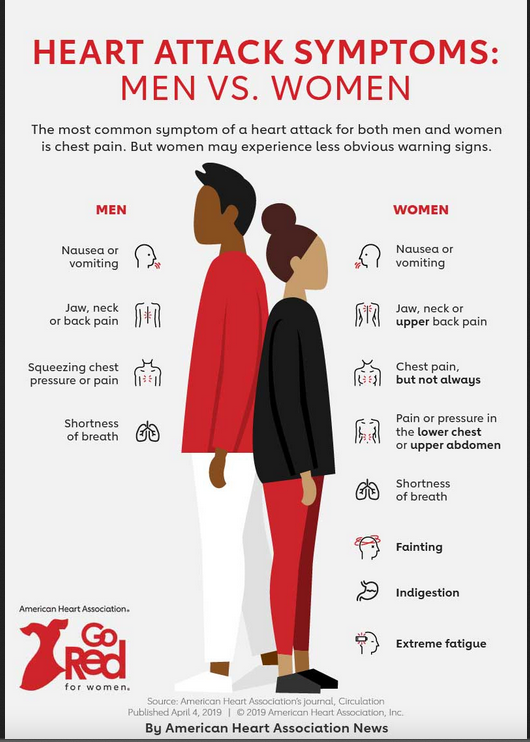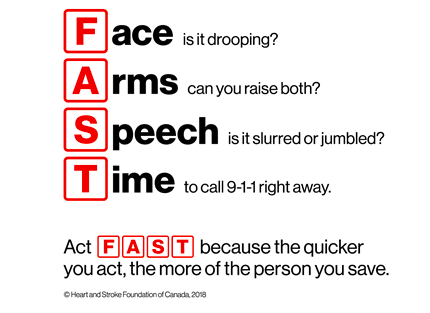The month of March recognizes World Day of the Fight Against Sexual Exploitation (March 4, find helpful information and resources), International Women’s Day (March 8) and Women’s History Month so there’s a lot of focus on women right now. It seems like a good time to talk about women’s health.
Heart attacks and strokes happen to both women and men, but they can present very differently. See below for an infographic on heart attack symptoms from the American Heart Association. While men and women may experience the same symptoms, women can also have additional symptoms that they don’t necessarily associate with heart attacks and therefore may not appreciate the seriousness of what they are experiencing. For example, women don’t always have chest pain, but will they realize that the jaw, neck or upper back pain they are feeling could be a sign of a heart attack?
Spontaneous Coronary Artery Dissection
Spontaneous Coronary Artery Dissection (SCAD) happens when blood can’t reach your heart due to a tear in an artery wall. This causes damage to your heart muscle, which affects your heart rhythm. The reduced blood flow can cause a heart attack or cardiac arrest.
According to Heart & Stroke, 90 per cent of SCAD happens to women. Women are typically between the ages of 30 and 60 when they suffer from SCAD. SCAD accounts for about 25 per cent of all heart attacks in women under 60 years old and severe stress, including from childbirth, appears to be a risk factor. Visit Heart & Stroke for a list of causes, symptoms, risk factors and other helpful information.
Stroke
Stroke is also experienced differently by women. Unfortunately, more women die of stroke, they have worse outcomes following a stroke and they don’t recover as quickly, easily or fully as men after stroke.
Similar to SCAD, the risk of stroke is higher during pregnancy. Women also have an increased risk of stroke during menopause.
Men and women exhibit the same symptoms of a stroke. Use the mnemonic FAST to spot symptoms and react.
Women experiencing a mini stroke, or transient ischemic attack (TIA), may actually be having a full stroke. The symptoms of both are identified by FAST, but a mini stroke can also present with different symptoms that usually appear suddenly and only last for a brief period. The NHS provides the following list of TIA signs and symptoms:
- Complete paralysis of one side of the body
- Sudden vision loss, blurred vision or double vision
- Vertigo
- Being sick
- Dizziness
- Confusion
- Difficulty understanding what others are saying
- Problems with balance and co-ordination
- Difficulty swallowing
There may be causes other than TIA for these symptoms; nevertheless, if you suspect it’s a stroke it’s imperative to call for an ambulance immediately.
Regenerative medicine research for stroke and damaged hearts
Canada is a leader in heart and stroke research, with regenerative medicine offering promising advancements. The following is a sample of some of the regenerative medicine work happening in Canada.
The Ottawa Hospital Research Institute (OHRI) is finding ways to stimulate the regeneration of brain tissue in stroke patients. In the last 20 years, there has been research to prove that stem cells exist in the adult brain and they can be coaxed into generating new brain cells. OHRI researchers are exploring the molecular switches that increase the number of stem cells in the brain.
The Ted Rogers Centre for Heart Research supports a multidisciplinary team of principal investigators at the University of Toronto. The Translational Biology and Engineering Program (TBEP) brings together engineers and scientists who are keen to learn what causes heart failure and discover new ways to diagnose and treat it. TBEP researchers are harnessing the power of regenerative medicine – cells, molecules and biomaterials – to regenerate the heart, and they are developing strategies, tools and technologies to ensure there won’t be rejection in the cardiac environment. Read about the work of scientists like James Ellis and Ian Scott.
BlueRock Therapeutics, with a significant presence in Toronto, has developed a cardiology platform based on the work of its founders Gordon Keller and Michael Laflamme. They have figured out how to create healthy heart cells from pluripotent stem cells and BlueRock is working to develop an “off-the-shelf” cell therapy that will help patients living with heart disease.
Established in 2002, the Heart & Stroke Foundation Canadian Partnership for Stroke Recovery is a multi-disciplinary, multi-site research partnership utilizing the expertise of stroke recovery researchers across Canada to develop solutions and treatments to restore the lives of those affected by strokes. At the University of Ottawa and OHRI, researchers are investigating molecular and cellular mechanisms of brain repair. Their work will help us understand how tissue in the nervous system grows and develops, and how to repair or replace nerve cells that have been damaged by injury or disease. This knowledge is expected to lead to new processes to enhance stroke recovery and brain health.
Stacey Johnson
Latest posts by Stacey Johnson (see all)
- Right Turn: Stem cell supplements: A growing market with growing risks - December 19, 2025
- Right Turn: Beyond the ’stache: The science, the progress, the promise - November 26, 2025
- Right Turn: Can Bryan Johnson live forever? Will regenerative medicine help him do so? - October 10, 2025








Comments